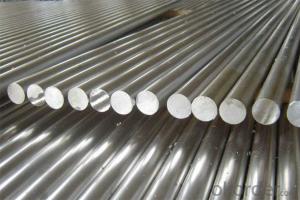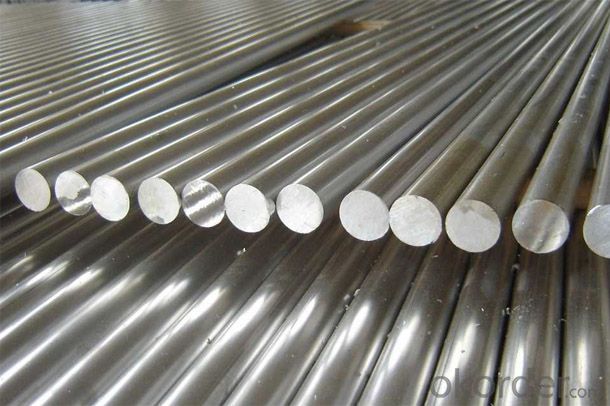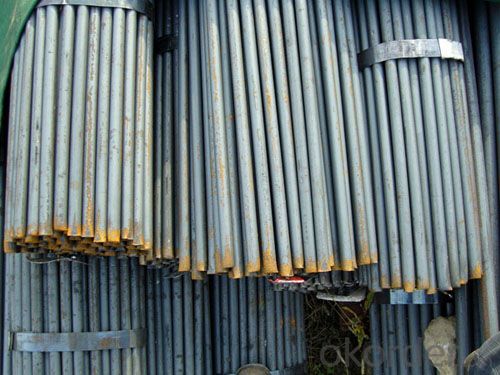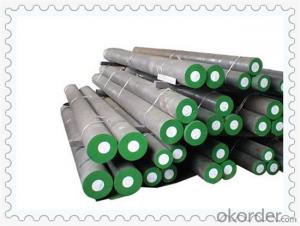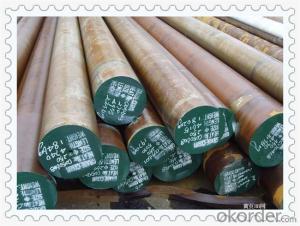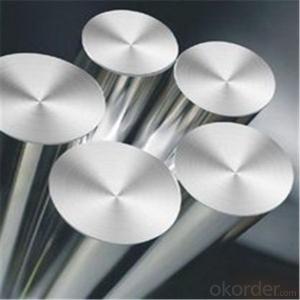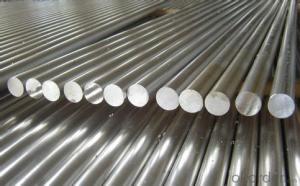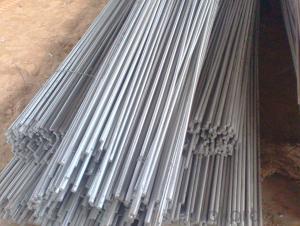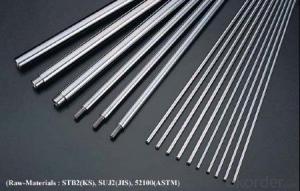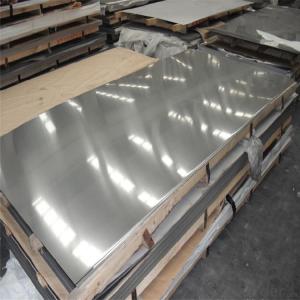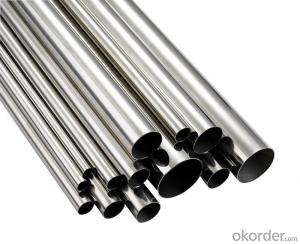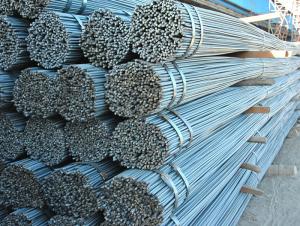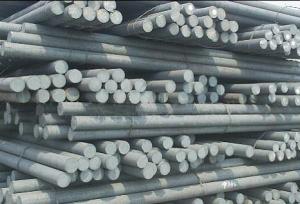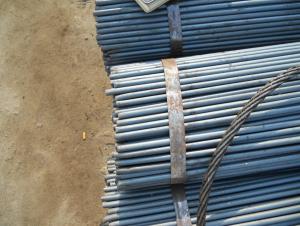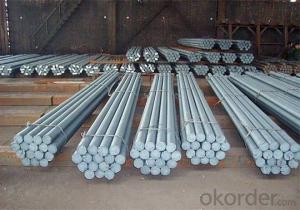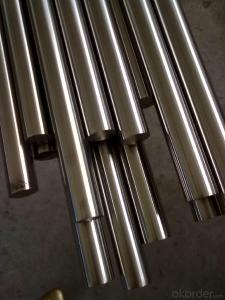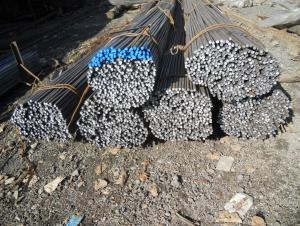Round Bars Popular Sell Cheap Price Stainless Steel 316
- Loading Port:
- Tianjin
- Payment Terms:
- TT or LC
- Min Order Qty:
- 27 m.t.
- Supply Capability:
- 24000 m.t./month
OKorder Service Pledge
OKorder Financial Service
You Might Also Like
Product Description:
OKorder is offering Round Bars Popular Sell Cheap Price Stainless Steel 316 at great prices with worldwide shipping. Our supplier is a world-class manufacturer of steel, with our products utilized the world over. OKorder annually supplies products to European, North American and Asian markets. We provide quotations within 24 hours of receiving an inquiry and guarantee competitive prices.
Product Applications:
Round Bars Popular Sell Cheap Price Stainless Steel 316 are ideal for structural applications and are widely used in the construction of buildings and bridges, and the manufacturing, petrochemical, and transportation industries.
Product Advantages:
OKorder's Round Bars Popular Sell Cheap Price Stainless Steel 316 are durable, strong, and resist corrosion.
Main Product Features:
· Premium quality
· Prompt delivery & seaworthy packing (30 days after receiving deposit)
· Corrosion resistance
· Can be recycled and reused
· Mill test certification
· Professional Service
· Competitive pricing
Product Specifications:
Stainless Steel Pipe
1 Cold roll cold draw pipe&tube
2.Grade: TP304,TP316L
3. Honor:CE/PED,AB
| Series | Top Quility steel Rod |
| Grade | 300 series(304, 304 L,304H,310,310S,316, 316 L,317L,321etc.) |
| Technics | Hot-rolled, Hot-forged, Cold-drawn, Centerless Gringing |
| Surface | Peeled, Bright, Polish |
| Diamete Rang | Peeled bright round bar: 3-400mm |
| Hot-rolled bar: 3-130mm | |
| Hot- forged bar: 130-400mm | |
| Cold-drawn: 3-40mm | |
| Centerless grinding bright round bar: 3-100mm | |
| Dia torlarance:H9-K12 | |
| Length | Radom length, Specified length, Multiple length ( no more than 9m) |
| Usage | These products are widely supplied to areas of machine-made industry, chemical industry, |
| shipping industry, rchitecture, food industry, household products etc | |
| Packaging | Standard export packing, according to customer's requirment |
| Delivery Time | up to the order quantity |
| Certification | CE/PED,ABS, DNV ,GL,LR |
| Application | Pipe and Tubes for petrochemical industry,pharmaceutical industry ,food industry, |
| aviation and aerospace industry,architectural decoration industry |
FAQ:
Q1: Why buy Materials & Equipment from OKorder.com?
A1: All products offered byOKorder.com are carefully selected from China's most reliable manufacturing enterprises. Through its ISO certifications, OKorder.com adheres to the highest standards and a commitment to supply chain safety and customer satisfaction.
Q2: How do we guarantee the quality of our products?
A2: We have established an advanced quality management system which conducts strict quality tests at every step, from raw materials to the final product. At the same time, we provide extensive follow-up service assurances as required.
Q3: How soon can we receive the product after purchase?
A3: Within three days of placing an order, we will begin production. The specific shipping date is dependent upon international and government factors, but is typically 7 to 10 workdays.
Q4: What makes stainless steel stainless?
A4: Stainless steel must contain at least 10.5 % chromium. It is this element that reacts with the oxygen in the air to form a complex chrome-oxide surface layer that is invisible but strong enough to prevent further oxygen from "staining" (rusting) the surface. Higher levels of chromium and the addition of other alloying elements such as nickel and molybdenum enhance this surface layer and improve the corrosion resistance of the stainless material.
Q5: Can stainless steel rust?
A5: Stainless does not "rust" as you think of regular steel rusting with a red oxide on the surface that flakes off. If you see red rust it is probably due to some iron particles that have contaminated the surface of the stainless steel and it is these iron particles that are rusting. Look at the source of the rusting and see if you can remove it from the surface.
Images:
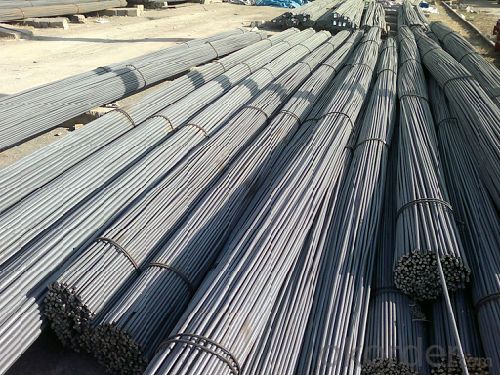
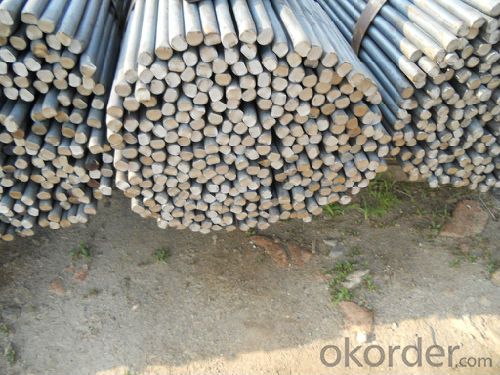
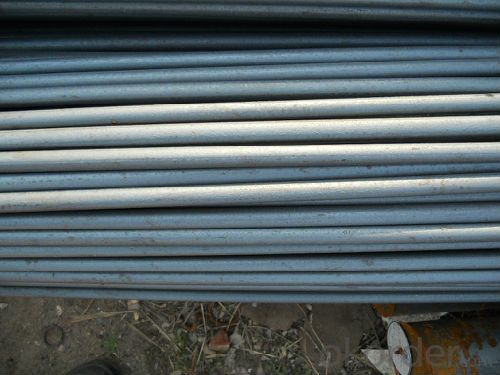
- Q: What is the difference between a rough turned and a hot rolled steel round bar?
- A rough turned steel round bar and a hot rolled steel round bar differ in their manufacturing processes and resulting properties. A rough turned steel round bar is produced by first heating a steel billet or ingot to a high temperature and then subjecting it to rough machining processes. The rough machining involves removing excess material from the surface of the bar to achieve a desired size and shape. This process results in a slightly smoother surface compared to the hot rolled bar, but it may still have some minor imperfections. Rough turned bars are often used in applications where a smoother surface finish is required, such as in machining operations. On the other hand, a hot rolled steel round bar is manufactured by heating a steel billet or ingot to extremely high temperatures and then passing it through a series of rolling mills. The hot rolling process involves reducing the thickness and increasing the length of the steel bar by compressing it between a set of rotating rolls. As a result, hot rolled bars have a rough, scaled surface with variations in diameter along their length. This textured surface provides excellent adherence for paint, coatings, or further processing. Hot rolled bars are commonly used in construction, manufacturing, and structural applications where mechanical properties such as strength and durability are important. In summary, the main difference between a rough turned and a hot rolled steel round bar lies in their manufacturing processes and surface finish. Rough turned bars undergo rough machining to achieve a smoother surface, while hot rolled bars are formed through high-temperature rolling, resulting in a rough, scaled surface. The choice between these two types of bars depends on the specific application and the desired properties, such as surface finish, strength, and adherence.
- Q: What is the tolerance level for steel round bars?
- The tolerance level of steel round bars can vary based on multiple factors, including the bar's grade, diameter, and industry standards. Typically, the tolerance level is specified in terms of diameter or diameter deviation. For instance, in manufacturing, the tolerance level can be defined as a specific range of diameters, such as +/- 0.001 inches or +/- 0.02 millimeters. This means that the actual diameter should fall within this range to meet the tolerance requirements. Alternatively, the tolerance level can be expressed as diameter deviation, which measures the difference between the actual diameter and the specified nominal diameter. This deviation is often presented as a percentage or a specific measurement, like +/- 0.5% or +/- 0.010 inches. It is important to acknowledge that certain industries, like aerospace or automotive, may have stricter tolerance requirements due to the need for precision and quality. In these cases, the tolerance specifications might be narrower to ensure compliance with performance and safety standards. Ultimately, it is crucial to refer to relevant industry standards, specifications, or customer requirements to determine the specific tolerance level for steel round bars in a particular application.
- Q: How do you measure the diameter tolerance of a steel round bar?
- The diameter tolerance of a steel round bar can be measured using a caliper or micrometer tool. The tool is used to measure the diameter of the bar at multiple points along its length. The measurements are then compared to the specified diameter tolerance range to determine if the bar falls within the acceptable limits.
- Q: What are the advantages of using nickel-titanium alloy steel round bars?
- There are several advantages of using nickel-titanium alloy steel round bars. Firstly, this alloy offers high strength and excellent corrosion resistance, making it suitable for various applications in industries such as aerospace, automotive, and medical. Additionally, nickel-titanium alloy steel has shape memory properties, allowing it to return to its original shape after deformation, making it ideal for applications requiring repeated bending or twisting. Furthermore, this alloy exhibits superelasticity, meaning it can withstand large amounts of strain without permanent deformation, providing enhanced durability and longevity. Overall, the unique combination of strength, corrosion resistance, shape memory, and superelasticity makes nickel-titanium alloy steel round bars a versatile and advantageous material choice.
- Q: What are the advantages of using aluminum-silicon alloy steel round bars?
- Aluminum-silicon alloy steel round bars offer numerous benefits: 1. Enhanced lightweight: By combining aluminum with silicon, the round bars become even lighter, making them easier to handle. This is especially advantageous in industries where weight reduction is crucial, like aerospace and automotive. 2. Exceptional strength: The mechanical properties of aluminum-silicon alloy steel round bars, such as high tensile and good yield strength, allow them to withstand heavy loads and provide structural integrity in various applications. 3. Resistance to corrosion: These round bars exhibit excellent resistance to corrosion, making them suitable for environments with moisture or chemicals. Thus, they can be used in applications exposed to harsh conditions or corrosive substances. 4. Efficient thermal conductivity: The round bars' excellent thermal conductivity facilitates efficient heat transfer. This property is particularly beneficial in industries like heat exchangers, where effective thermal management is essential. 5. Easy machinability: Aluminum-silicon alloy steel round bars are relatively easy to machine, allowing for precise shaping and forming. This makes them ideal for applications requiring intricate designs or specific dimensions. 6. Cost-effective solution: Compared to other materials, aluminum-silicon alloy steel round bars offer a cost-effective solution due to their low production and maintenance costs. This makes them popular in construction, automotive, and manufacturing industries. 7. Environmentally friendly: Aluminum-silicon alloy steel round bars are highly recyclable, which is crucial in today's environmentally conscious world. Recycling these alloys requires less energy compared to primary production, making them a sustainable choice. In conclusion, the advantages of aluminum-silicon alloy steel round bars encompass their lightweight nature, high strength, corrosion resistance, thermal conductivity, machinability, cost-effectiveness, and recyclability. These properties make them a versatile material for a wide range of applications across various industries.
- Q: How do you calculate the weight of a steel round bar based on its length, diameter, and density?
- In order to determine the weight of a steel round bar, it is necessary to utilize the formula for calculating the volume of a cylinder, which is then multiplied by the density of the steel. Here are the steps to be followed: 1. Determine the radius or diameter of the steel round bar. If the diameter is known, divide it by 2 to obtain the radius. 2. Compute the volume of the round bar by applying the formula V = πr^2h, where V represents the volume, π denotes a mathematical constant roughly equal to 3.14159, r indicates the radius, and h symbolizes the length of the round bar. 3. If the diameter, radius, and length are expressed in different units of measurement, convert them to the same unit. 4. Multiply the volume of the round bar by the density of steel. The density of steel varies depending on the type and grade, but a commonly used value is 7.85 g/cm^3 or 7850 kg/m^3. For instance, suppose there is a steel round bar with a diameter of 2 cm, a length of 50 cm, and a density of steel equal to 7850 kg/m^3. 1. Calculate the radius: r = 2 cm / 2 = 1 cm. 2. Determine the volume: V = π(1 cm)^2 * 50 cm = 50π cm^3. 3. Convert the volume to cubic meters: V = 50π cm^3 * (1 m / 100 cm)^3 = 50π * 10^-6 m^3. 4. Compute the weight: Weight = volume * density = 50π * 10^-6 m^3 * 7850 kg/m^3 = 0.3925 kg. Therefore, the approximate weight of the steel round bar is 0.3925 kg.
- Q: Are steel round bars available in different lengths?
- Indeed, there is a variety of lengths for steel round bars. These bars are designed in diverse lengths to cater to various needs and applications. The range of lengths may differ depending on the supplier or manufacturer. Typically, steel round bars are commonly available in lengths between 6 and 12 feet. However, it is also possible to acquire custom lengths through special requests. This wide range of options grants more flexibility in construction and fabrication projects, as it facilitates the ability to cut or modify the bars according to specific requirements.
- Q: What are the advantages of using nickel-cobalt alloy steel round bars?
- Using nickel-cobalt alloy steel round bars has several benefits: 1. Exceptional strength and toughness: Nickel-cobalt alloy steel round bars are incredibly strong and tough, making them ideal for heavy-duty applications. The addition of nickel and cobalt enhances the overall strength and hardness of the steel, enabling it to withstand high stress and pressure. 2. Excellent resistance to corrosion: Nickel-cobalt alloy steel is highly resistant to corrosion and oxidation. This makes it the preferred choice in environments where exposure to moisture, chemicals, or harsh weather conditions is common. Its resistance to corrosion ensures durability and longevity, reducing the risk of rust or deterioration. 3. Superior heat resistance: Nickel-cobalt alloy steel round bars possess exceptional heat resistance properties. They can withstand high temperatures without compromising their structural integrity, making them suitable for heat treatment applications like forging or welding. This heat resistance ensures that the bars maintain their mechanical properties even under extreme thermal conditions. 4. Enhanced wear resistance: The combination of nickel and cobalt in the alloy enhances its resistance to wear. Nickel-cobalt alloy steel round bars exhibit excellent resistance to abrasion, erosion, and fatigue, making them ideal for industries such as mining, construction, and automotive, where wear and tear are common. 5. Easy machinability: Nickel-cobalt alloy steel round bars are relatively easy to machine and fabricate. This makes them suitable for various manufacturing processes, including cutting, drilling, and shaping. The alloy's machinability allows for efficient production and reduces manufacturing costs. 6. Versatility for diverse applications: Nickel-cobalt alloy steel round bars have a wide range of applications due to their versatile properties. They can be used in industries such as aerospace, marine, oil and gas, automotive, and power generation. The alloy's combination of strength, corrosion resistance, and heat resistance makes it adaptable to various environments and demanding applications. In conclusion, nickel-cobalt alloy steel round bars offer numerous advantages, including exceptional strength, corrosion resistance, heat resistance, wear resistance, easy machinability, and versatility. These properties make them the preferred choice for various industrial applications, ensuring durability, reliability, and high-performance levels.
- Q: What is the difference between a centerless ground and a hot rolled steel round bar?
- The main difference between a centerless ground steel round bar and a hot rolled steel round bar is the manufacturing process. Centerless grinding involves removing material from the bar's outer diameter using abrasive wheels, resulting in a precise and smooth finish. On the other hand, hot rolling involves heating the steel and passing it through a series of rollers to shape it into a round bar, often resulting in a rougher surface. Additionally, centerless ground bars tend to have tighter dimensional tolerances and better surface quality compared to hot rolled bars.
- Q: Can steel round bars be used in high temperature applications?
- Yes, steel round bars can be used in high temperature applications. Steel is known for its excellent strength and durability, even at high temperatures. However, the specific type of steel and its composition should be considered to ensure it is suitable for the particular high temperature environment and application. Additionally, proper heat treatment and other measures may be necessary to enhance the steel's resistance to high temperatures and prevent any potential degradation or failure.
Send your message to us
Round Bars Popular Sell Cheap Price Stainless Steel 316
- Loading Port:
- Tianjin
- Payment Terms:
- TT or LC
- Min Order Qty:
- 27 m.t.
- Supply Capability:
- 24000 m.t./month
OKorder Service Pledge
OKorder Financial Service
Similar products
Hot products
Hot Searches
Related keywords
